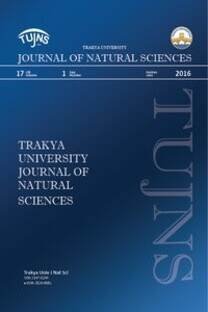EKSTRÜZYON TİPİ DÖVME PROSESLERİNDE FARKLI KALIP GEOMETRİLERİNİN KUVVET ve MALZEME AKIŞINA ETKİSİ
Ekstrüzyon Tipi Dövme, Geometrik Etki, Metal Akışı
Influence of the Die Geometry on Load and Metal Flow in Extrusion-Forging Processes
Extrusion Forging, Geometric Conditions, Metal Flow,
___
- Kudo, H., Some Analytical Experimental Studies of Axisymmetric Cold Forging and Extrusion, Int. J. Mech. Sci., 1960; 2:71-117.
- Rowe, G.W., Principles of Industrial Metalworking Processes, Arnold, London, 1997.
- Jain, S.C., Bramley, A.N., Lee, C.H. and Kobayashi, S., Theory and Experiments in Extrusion Forging, Proc. 11th MTDR Conf. Birmingham, Sept.1970, 1097-1115.
- Hu, W., Hashimi, M.S.J., Study of Metal Flow in Ekstrüzyon Forging of Rectangular Billets, J. Mat. Pro. Tech., 1994, 43:51-59.
- Hashmi, M.S.J., Klemz, F.B., Axisymmetric Extrusion Forging: Effects of Material Property and Product Geometry, Int. J. Mach. Tool Des. Res. 1986, 26(2):157-170.
- Giardini, C., Ceretti, E. and Maccarini, G., Formability in Extrusion Forging: The Influence of Die Geometry and Friction Conditions, J. Mat. Pro. Tech., 1995, 55:305-308.
- Monaghan, J., Brayden, L., An Analysis of an Open and Closed-Die Extrusion Forging Process, Proc. IMC-5, Queens Univ. Belfast, 1988, 273-287.
- Monaghan, J., Brayden, L., An Analysis of a Closed-Die Extrusion Forging Process, Proc. IMC-6, Dublin City Univ., 1989, 310-332.
- Vickery, J., Monaghan, J., An Investigation of the Early Stages of a Forging Extrusion Process, Proc. IMC-8, Univ. Ulster, 1991, 327-342.
- 0] Vickery, J., Monaghan, J., An Upper Bound Analysis of a Forging-Extrusion J. Mat. Pro. Tech., 1995, 55:103110.
- 1] Hwang, B.C., Hong, S.J. and Bae, W.B., An UBET Analysis of Non-Axisymmetric Extrusion/Forging Process, J. Mat. Pro. Tech., 2001, 111:135-141.
- 2] Wu, C.Y., Hsu, Y.C., The Influence of Die Shape on the Flow Deformation of Extrusion Forging, J. Mat. Pro. Tech., 2002, 124:67-76.
- 3] Lin, S.Y., Lin, F.C., Influences of the Geometrical Conditions of die and Workpiece on the Barreling Formation During Forging-Extrusion Process, J. Mat. Pro. Tech., 2003, 140:54-58.
- 4] Mısırlı, C., Çan, Y. ve Altınbalık, M.T., Ekstrüzyon Tipi Dövme Prosesi Üzerine Teorik Bir Çalışma, II. MBGAK, İstanbul, 17-19 Kasım 2005, 286-294.
- 5] Narayanasamy, R., Baskaran, K., Arunachalam, S,, and Krishna, D.M., An Experimental Investigation on Barreling of Aluminium Alloy Billets during Extrusion Forging Using Different Lubrications, Mat&Des., 2008, 29:2076-2088.
- ISSN: 1305-6468
- Başlangıç: 2000
- Yayıncı: -
İKİ FARKLI ISITICIYLA ISITILMIŞ DİKDÖRTGEN BİR KAPALI BÖLGE İÇİNDE DOĞAL KONVEKSIYONLA ISI TRANSFERİ
İKİ SABİT ISI KAYNAĞIYLA ISITILMIŞ EĞİK KARE BİR KAPALI BÖLGEDE DOĞAL KONVEKSIYONLA ISI TRANSFERİ
Farklı Yarasa (Chiroptera) Türlerinin Beyaz Kan Hücresi Sayımı
Serbülent PAKSUZ, Emine Pınar PAKSUZ, Beytullah ÖZKAN
KABLOSUZ AĞLARDA KAYNAK YÖNETİMİ
Aytül BOZKURT, Erdem UÇAR, Rafet AKDENİZ
DISTRIBUTION of FRESHWATER CRAB (Potamon sp.) in TURKISH THRACE
THE DETERMINATION OF SURFACE HARDNESS OF READY- MIXED CONCRETE APPLICATIONS IN EDIRNE BY USE OF
Schmidt HAMMER, Sabit OYMAEL, Ünal SEVER
KEPSUT DERELİ KÖYÜ CAMİİ VE TEMEL KORUMA YAKLAŞIMI
BİRLEŞİK VE EĞİK TÜRKÇE EL YAZISI TANIMADA K-NN SINIFLAMA YÖNTEMİ VE SÖZLÜK KULLANIMI
Murat ŞEKERCİ, Rembiye KANDEMİR
EKSTRÜZYON TİPİ DÖVME PROSESLERİNDE FARKLI KALIP GEOMETRİLERİNİN KUVVET ve MALZEME AKIŞINA ETKİSİ
BASAMAKLI CMMI MODELİ ile EXTREME PROGRAMMING METODUNUN DEĞERLENDİRİLMESİ
Emin BORANDAĞ, Fatih YÜCALAR, Senol Zafer ERDOGAN, Fuat İNCE, Crystal FAMİLY
